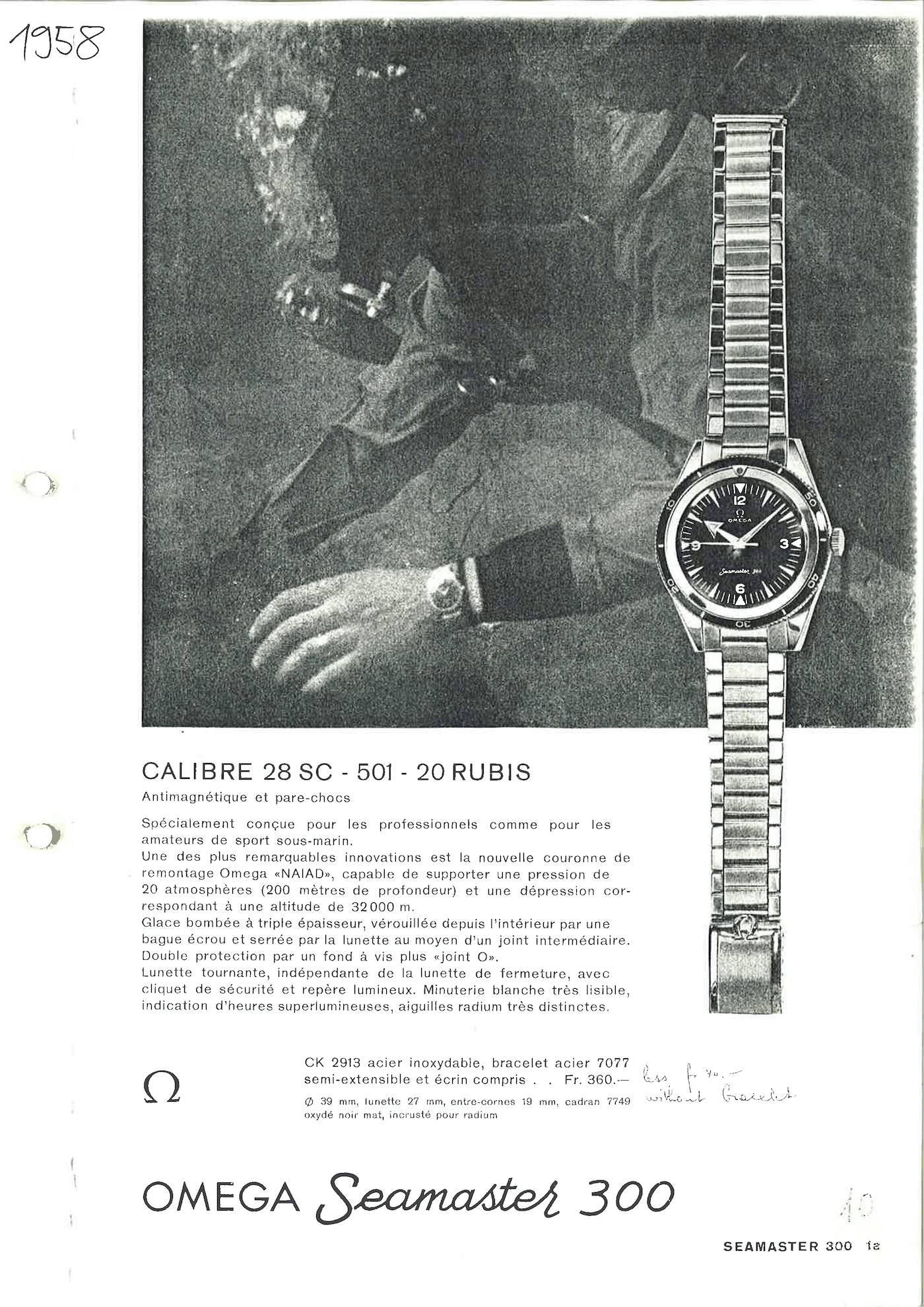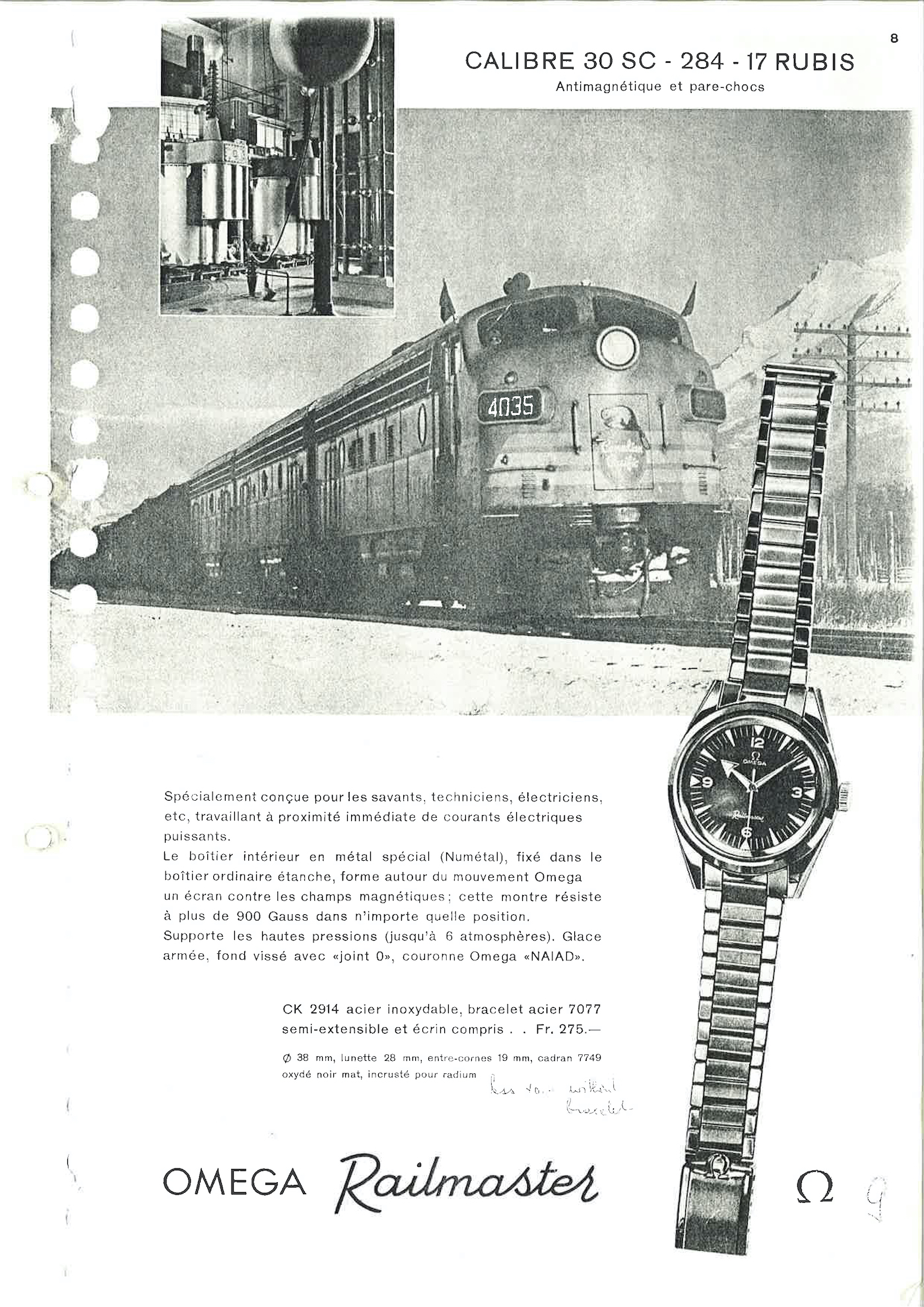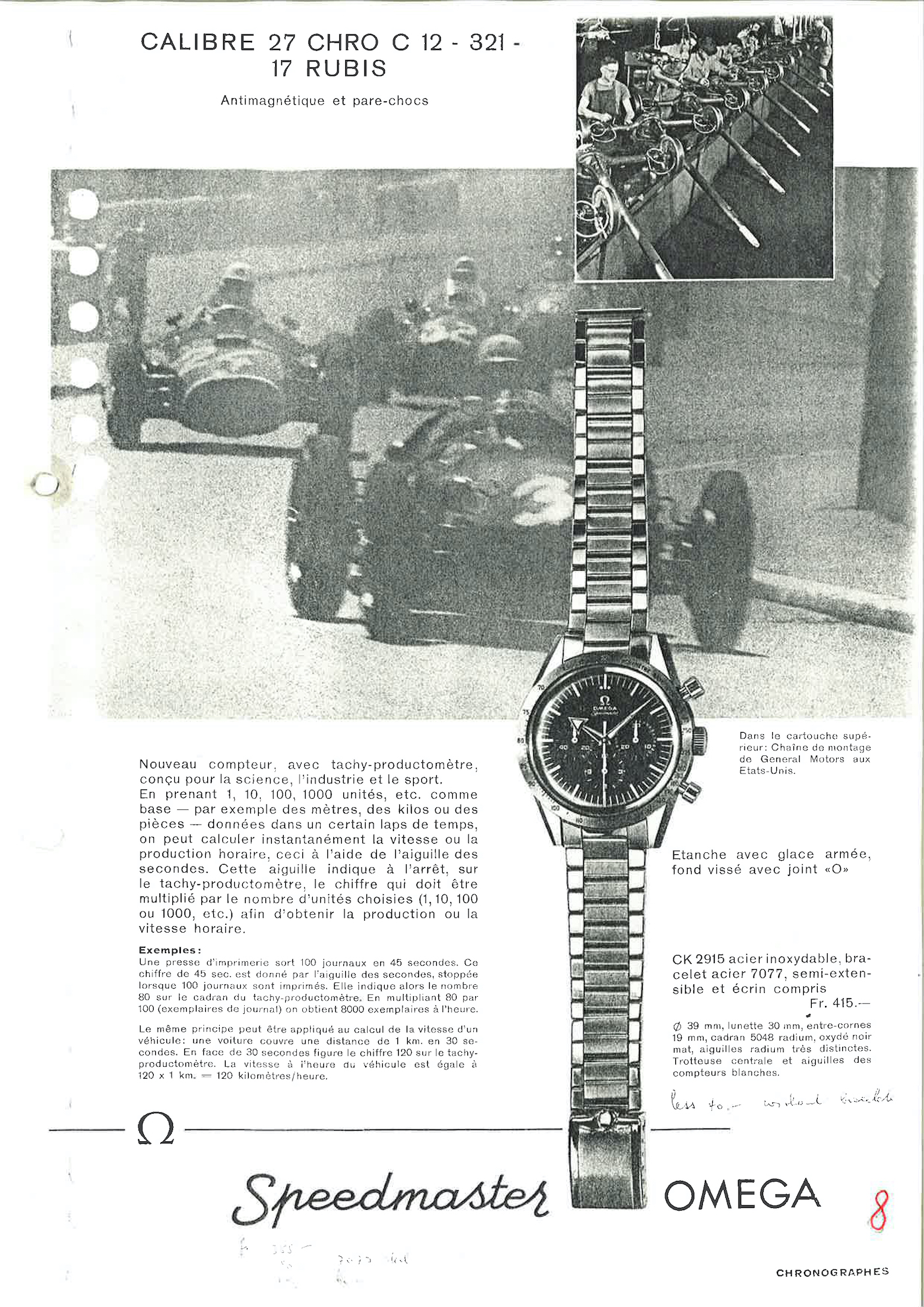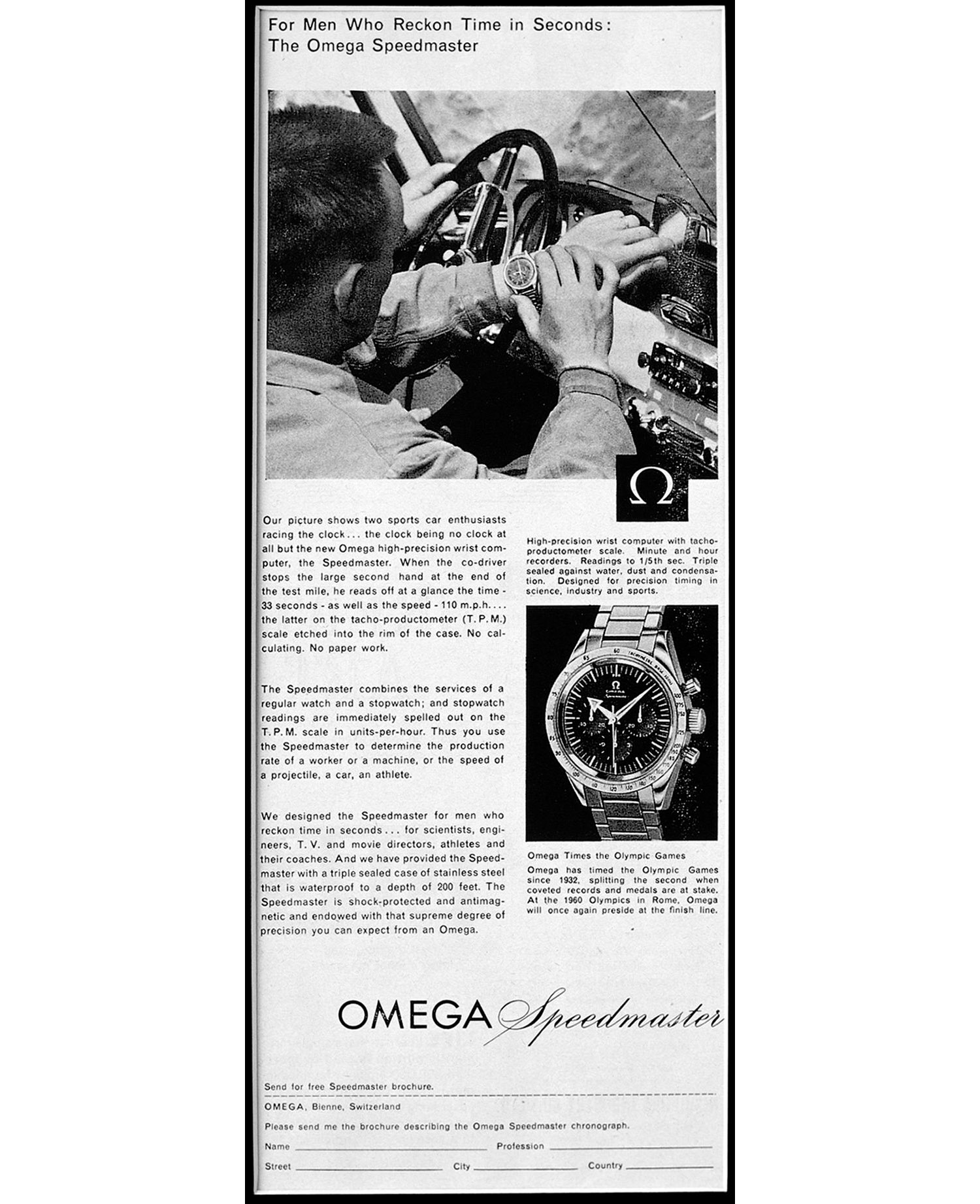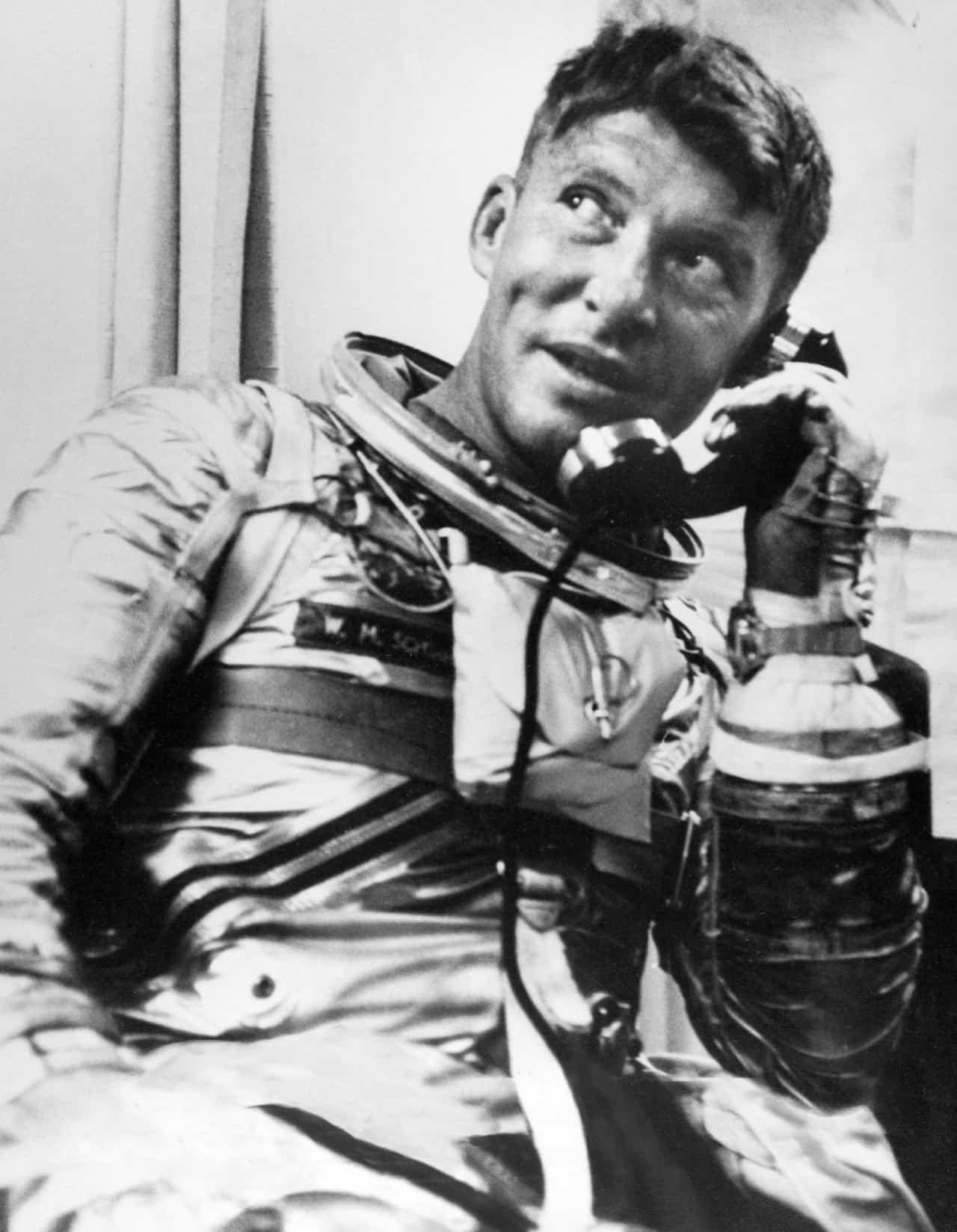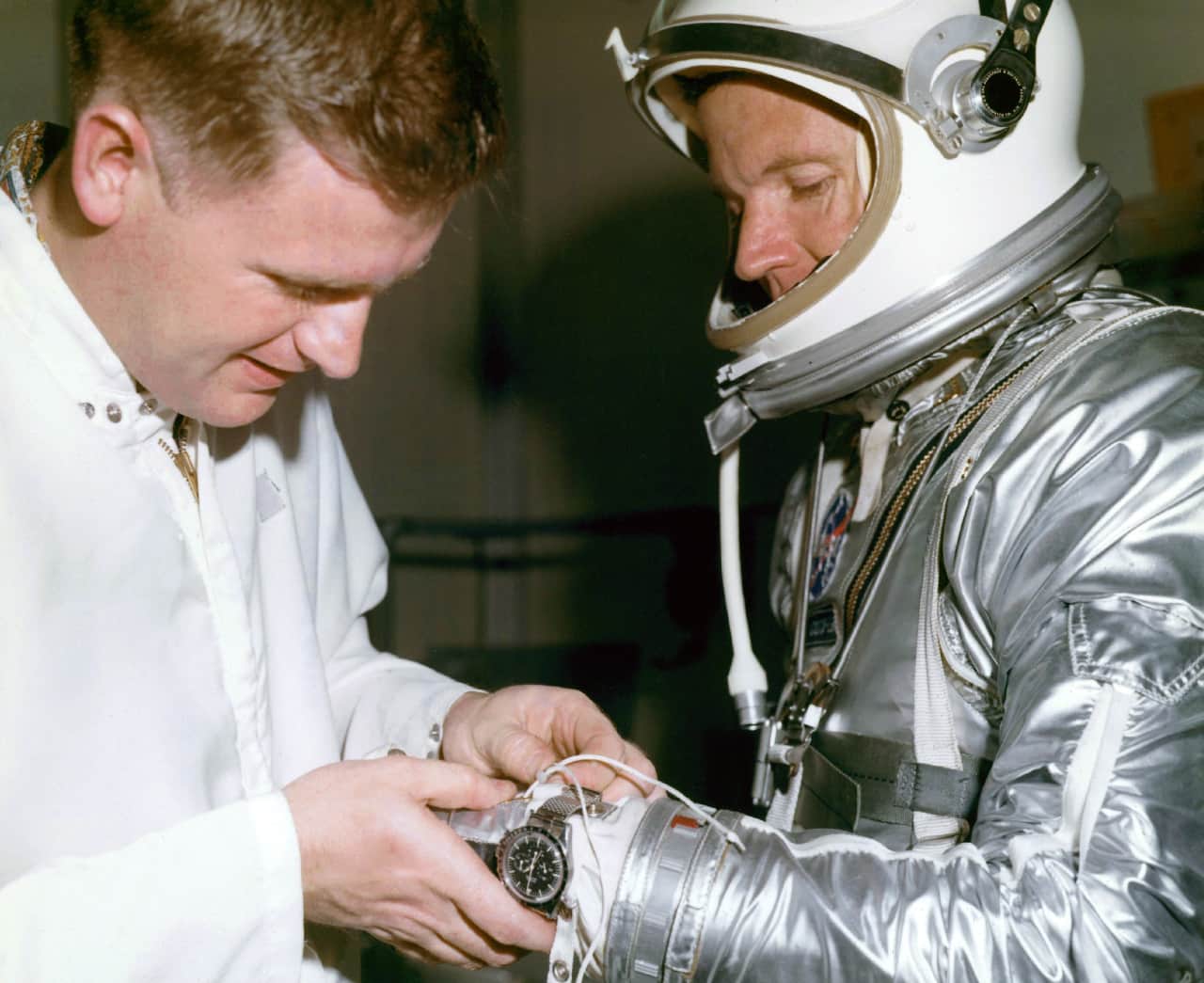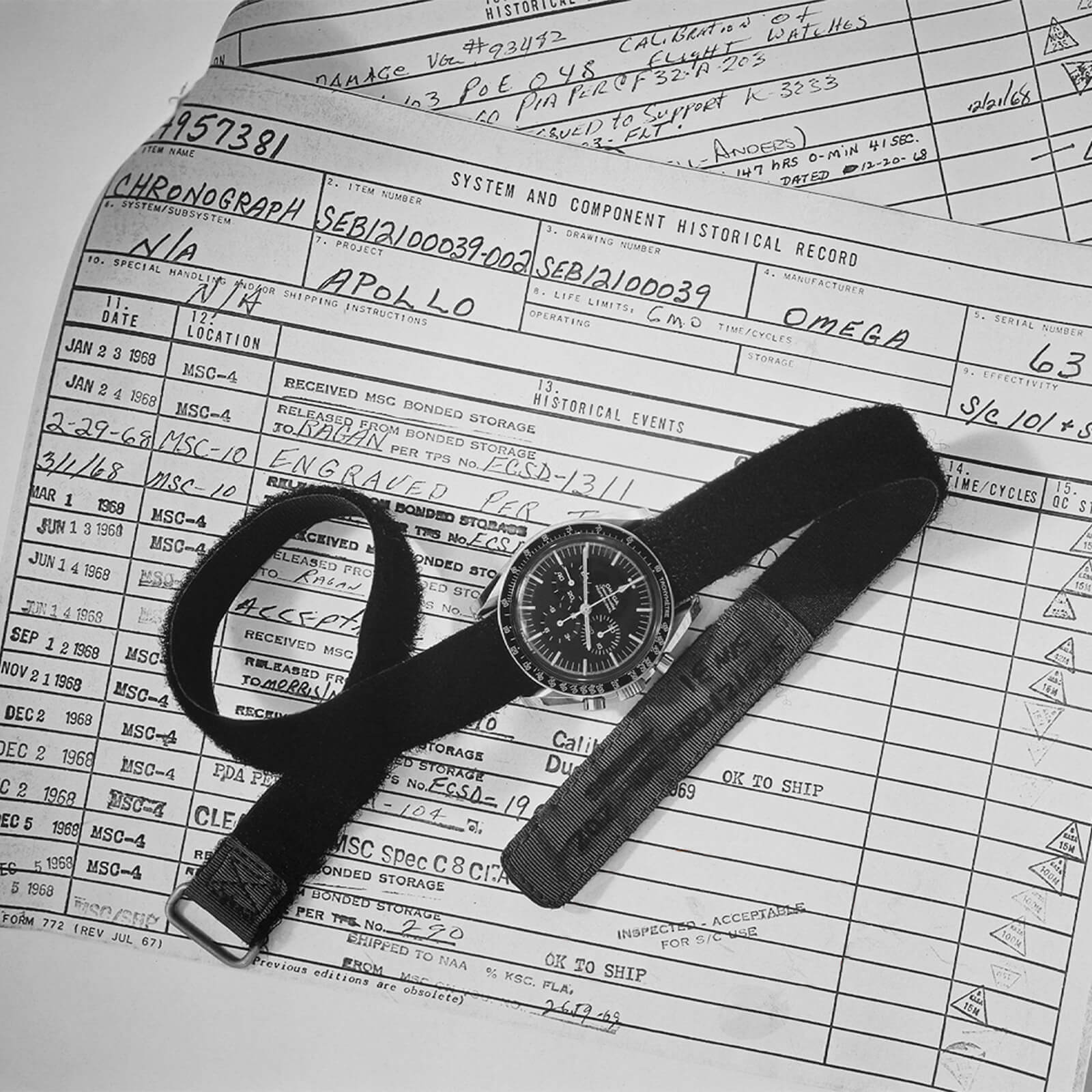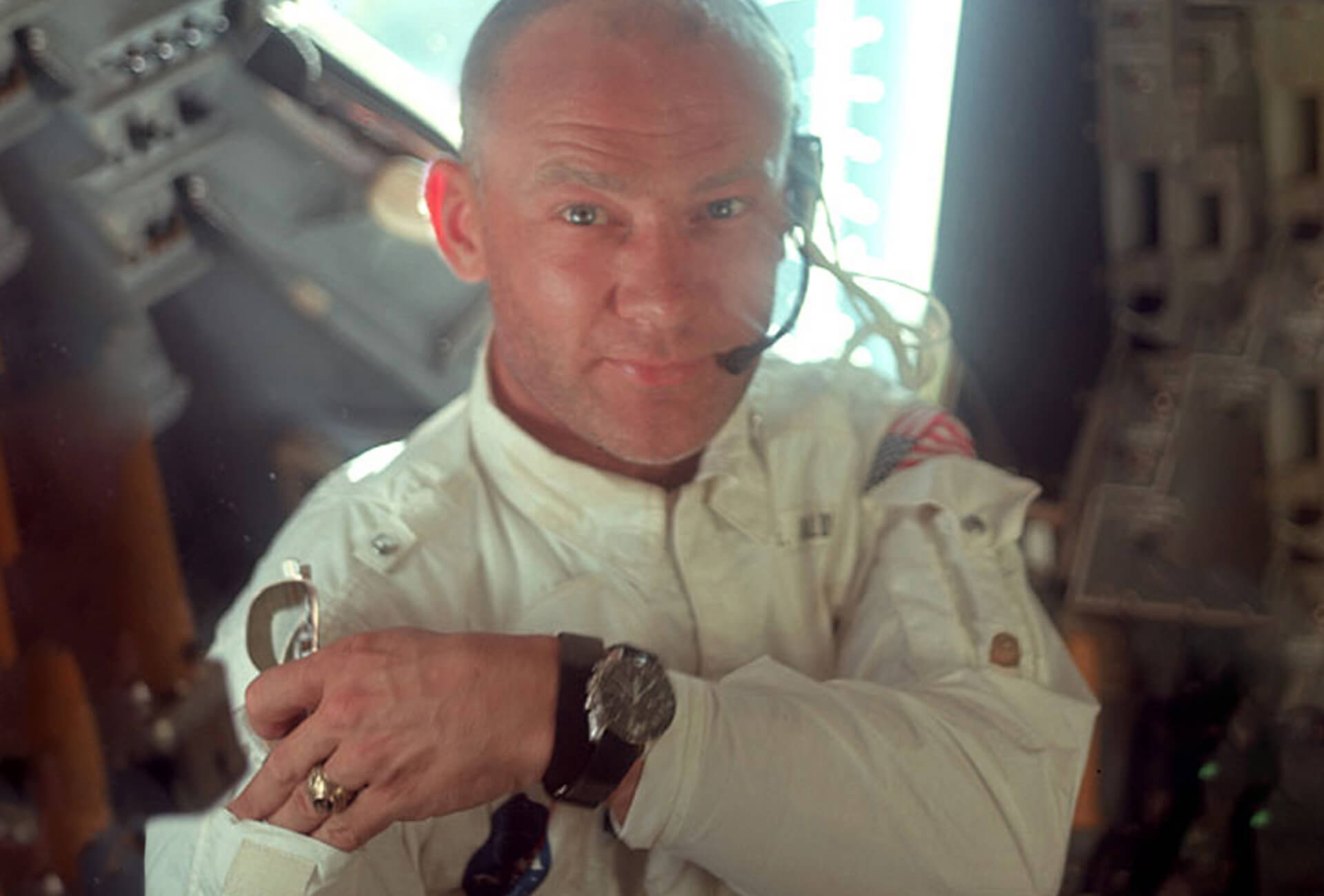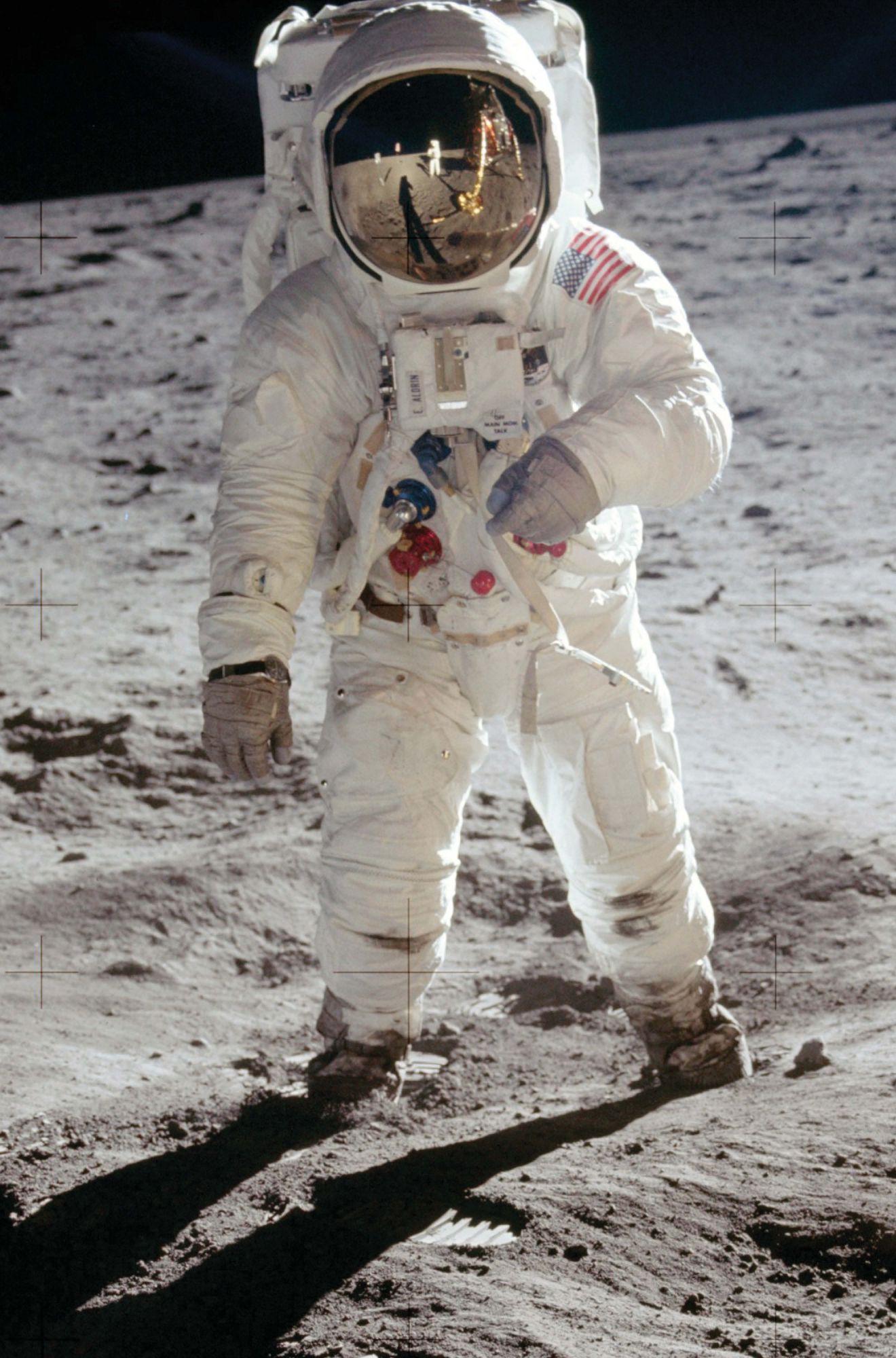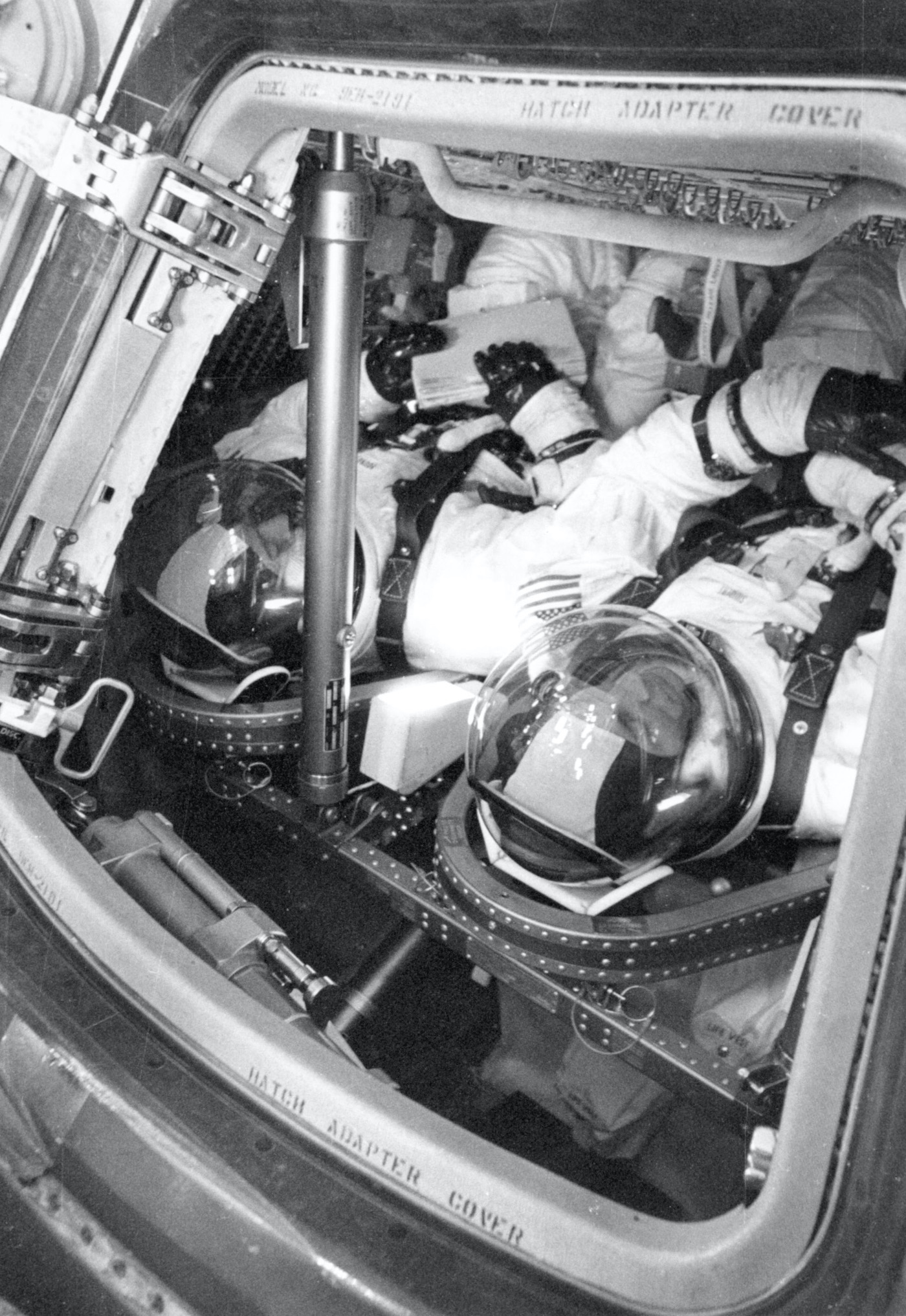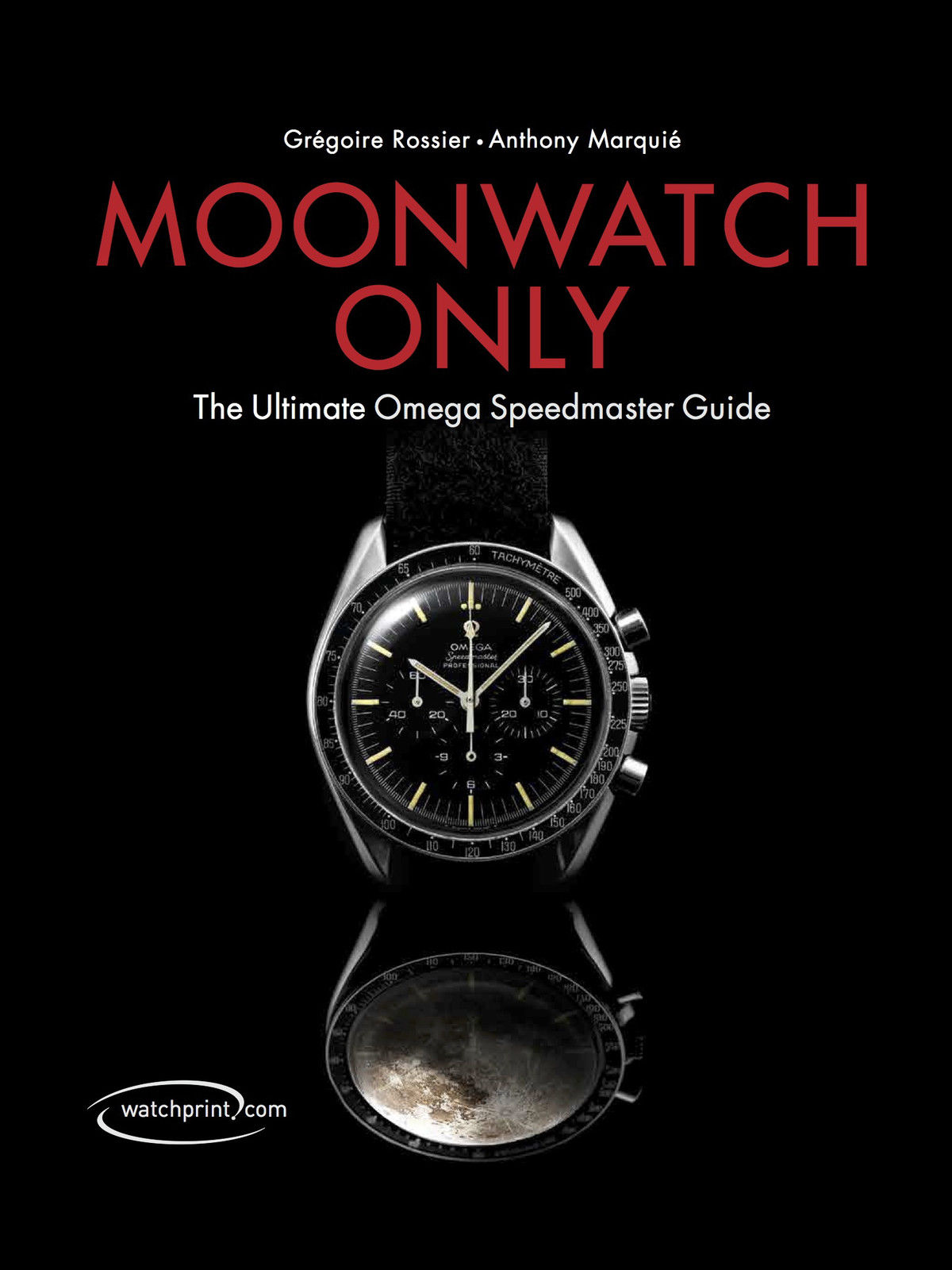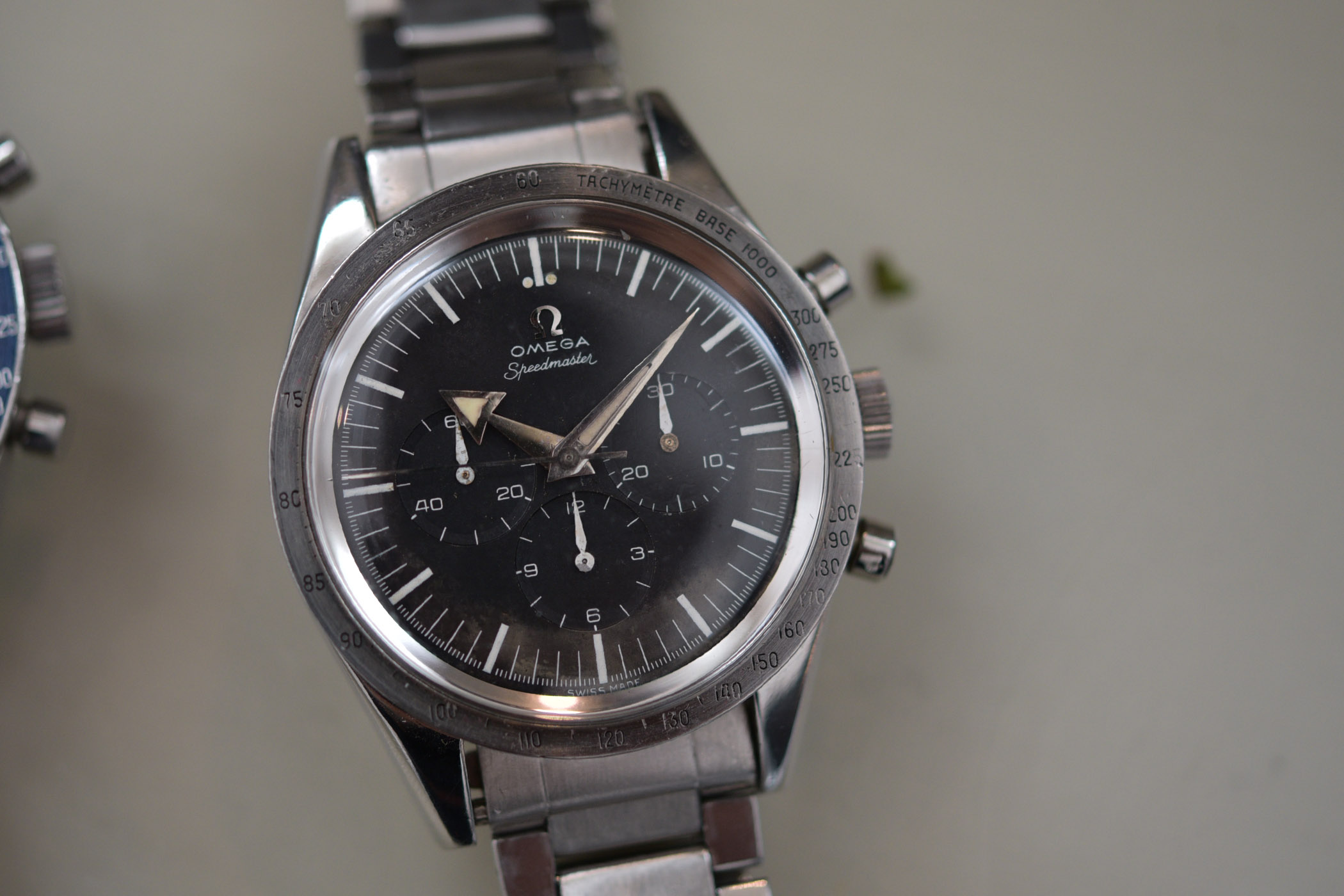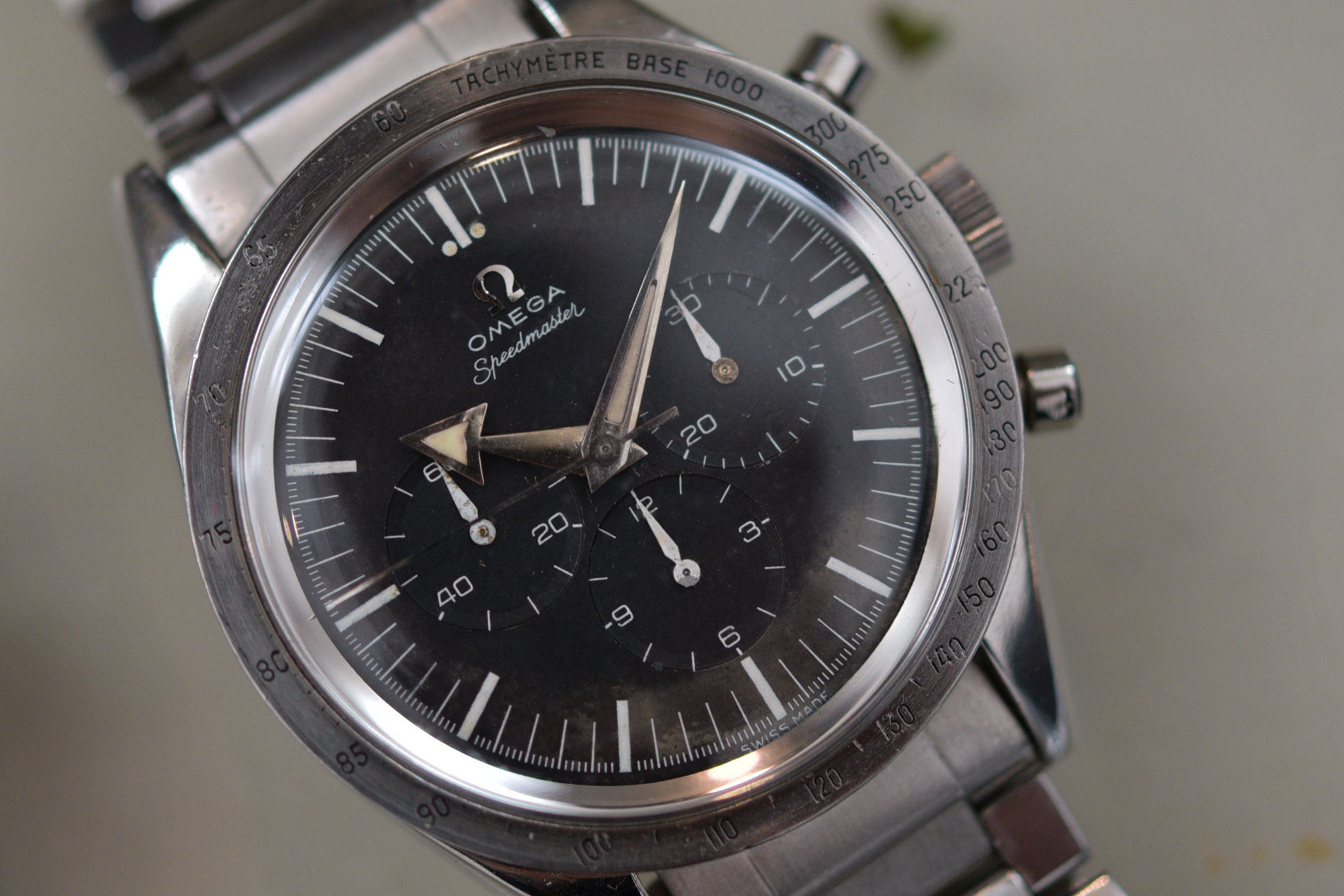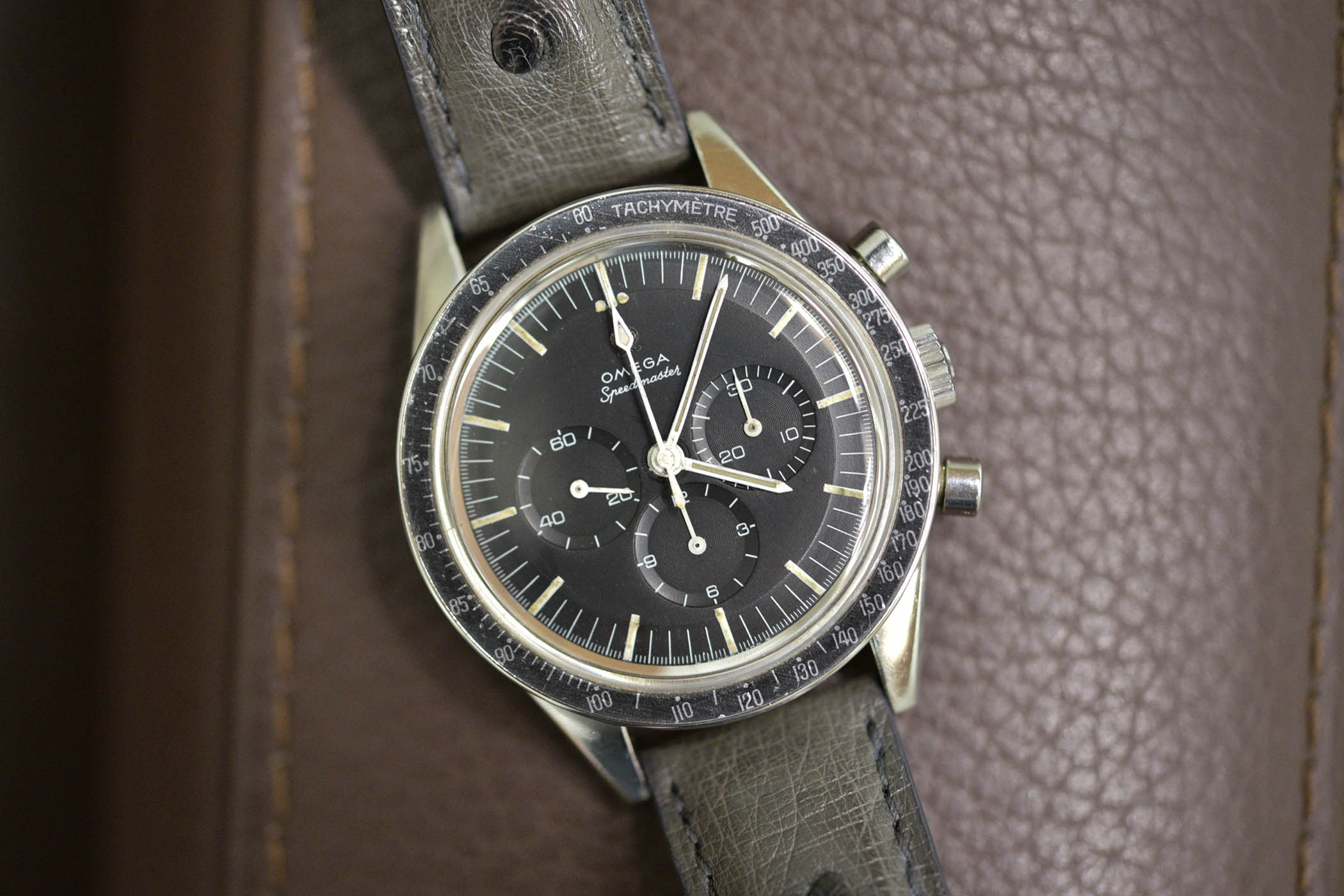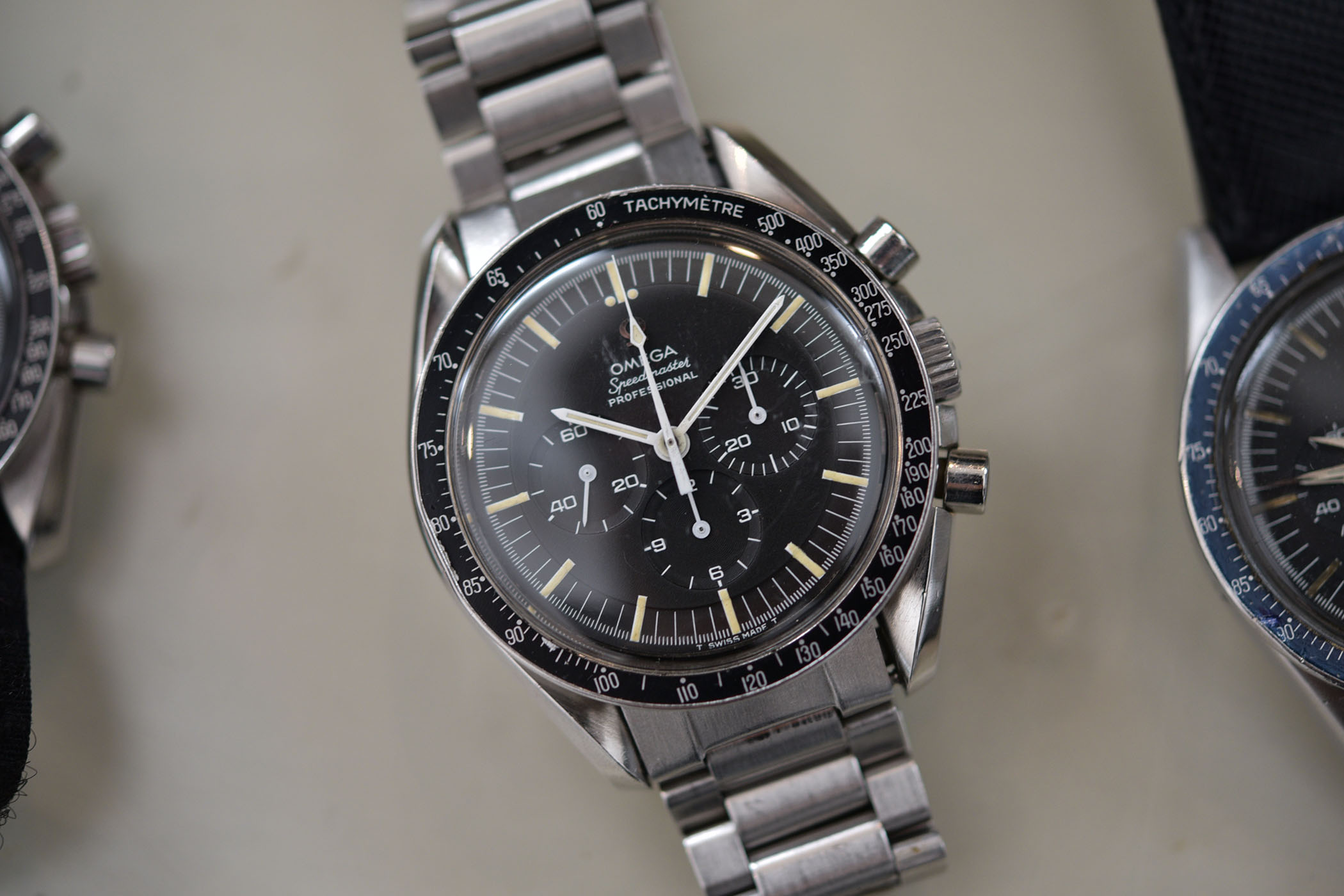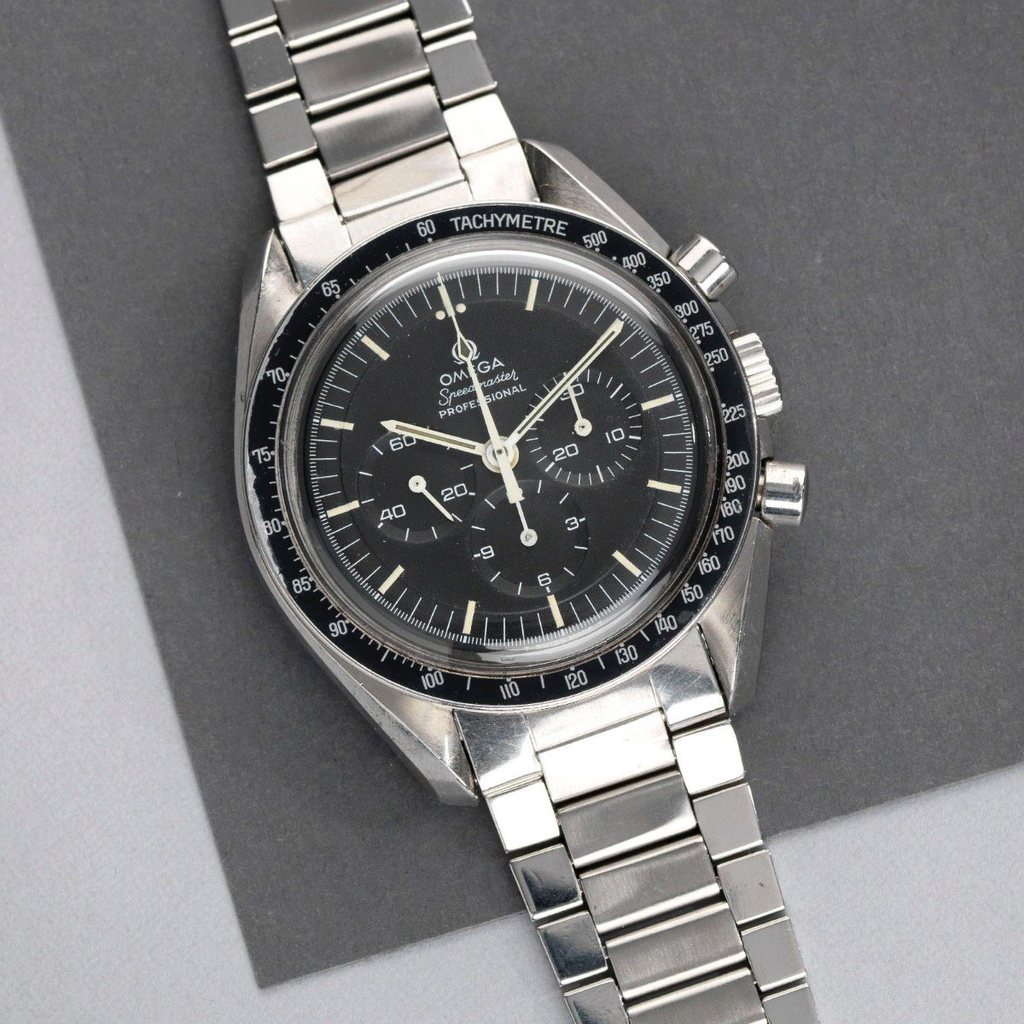A Guide to the Evolution of the Omega Speedmaster Moonwatch, Reference by Reference
The evolution of the Speedmaster to the Moonwatch and an identikit of its most iconic references.
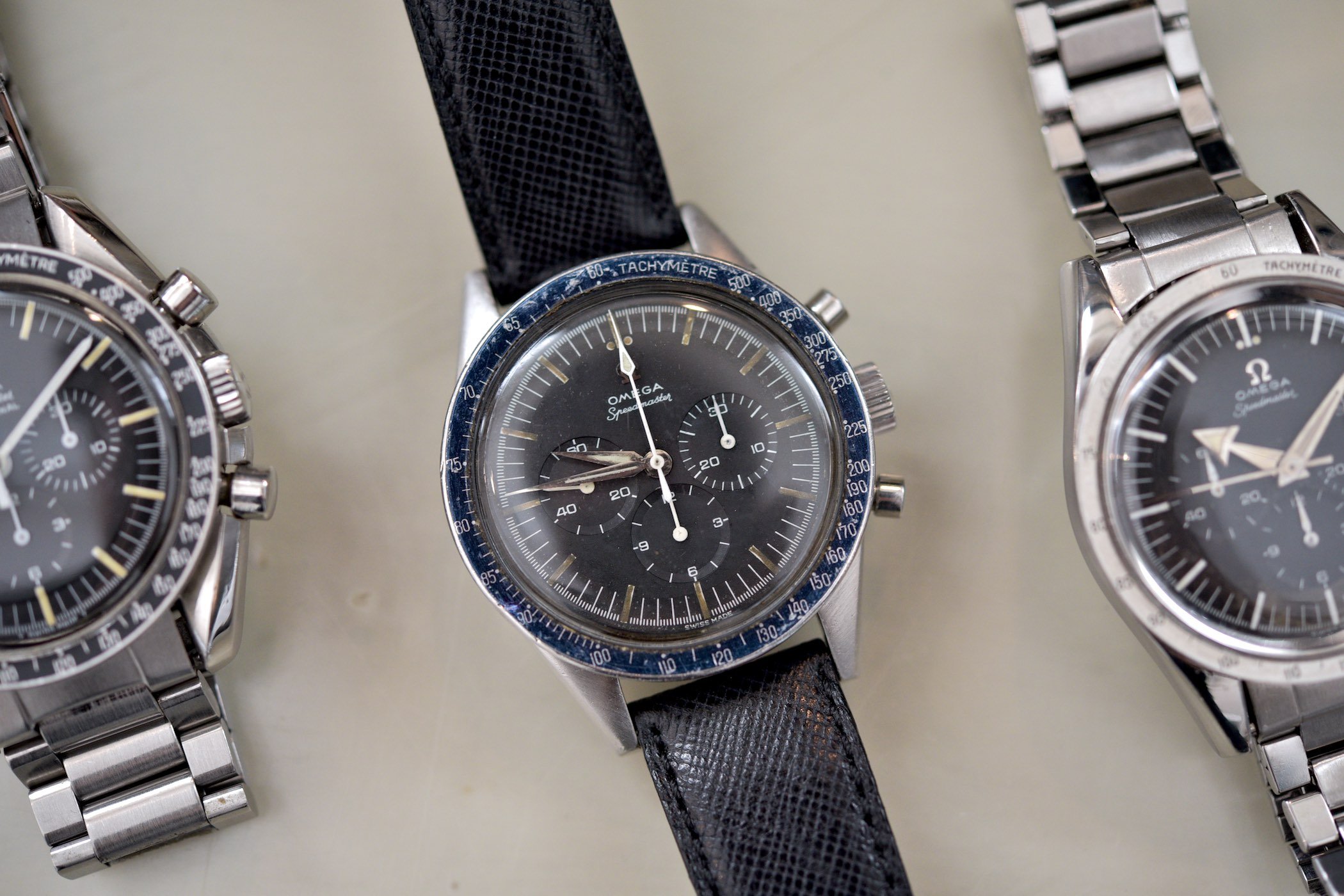
No other watch on Earth can boast the space credentials of the Speedmaster, the one and only watch worn on the Moon. The curious fact about the Speedmaster is that it wasn’t designed to go to the Moon. Nobody at Omega could have foreseen that the Speedmaster would soon be orbiting out of the Earth’s atmosphere to join man on the greatest adventure of all. Born in 1957 as part of a trilogy of instrument watches, the Speedmaster was originally designed for car racers or anybody interested in measuring elapsed times with 1/5th of a second accuracy. The first chronograph of its kind to feature a tachymetre scale on the external bezel, the Speedmaster responded to an internal mandate for a sturdy, precise, waterproof watch that was reliable, legible and easy to manipulate. Today we are going to dig in deep with the Speedmaster and provide you with a compilation of the most ‘iconic’ references – and therefore the ones most coveted by collectors – that marked the evolution of this extraordinary watch which is still in production today.
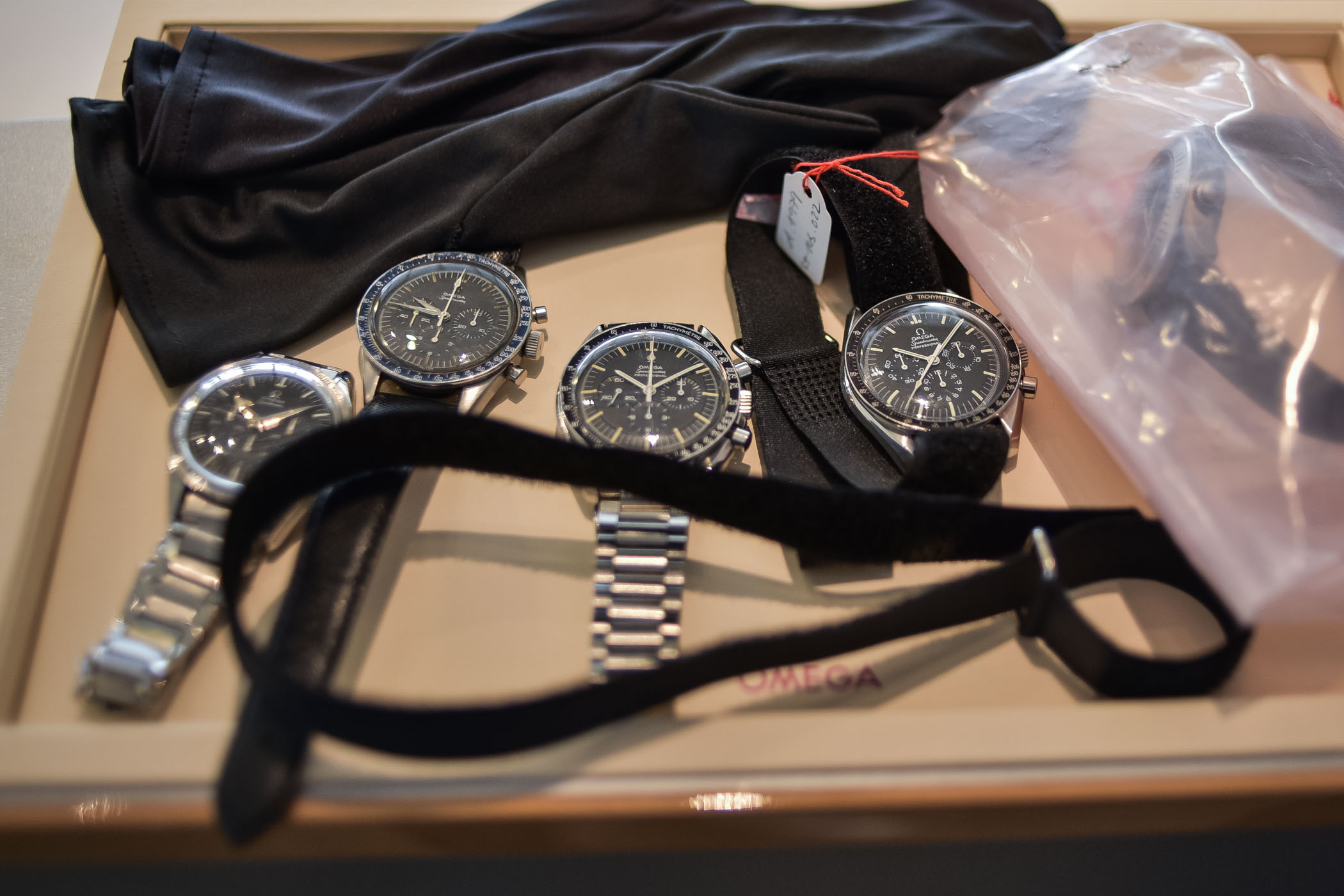
Trilogy of 1957 Master Watches
The Speedmaster formed part of a trilogy of Master instrument watches launched by Omega in 1957. There was the Seamaster 300 CK 2913 with waterproof properties for divers, the Railmaster CK 2914 with anti-magnetic properties for engineers, and the Speedmaster CK 2915 with stopwatch functionality for car racers et al. The names Flightmaster and Chronomaster were suggested for the chronograph, but the Speedmaster name won hands down.
A print advert of 1958 dedicated to the Speedmaster depicts two men in a convertible sports car as the co-pilot raises his left wrist to call out the elapsed time and speed to the driver. The headline of the ad says it all: For Men Who Reckon Time in Seconds: The Omega Speedmaster, which included “scientists, engineers, T.V. and movie directors, athletes and their coaches’”, and basically anything that moved and needed an exact 1/5th of a second timing. After all, Omega was by then the Official Olympic Timer and responsible for “splitting the second when coveted records and medals are at stake”.
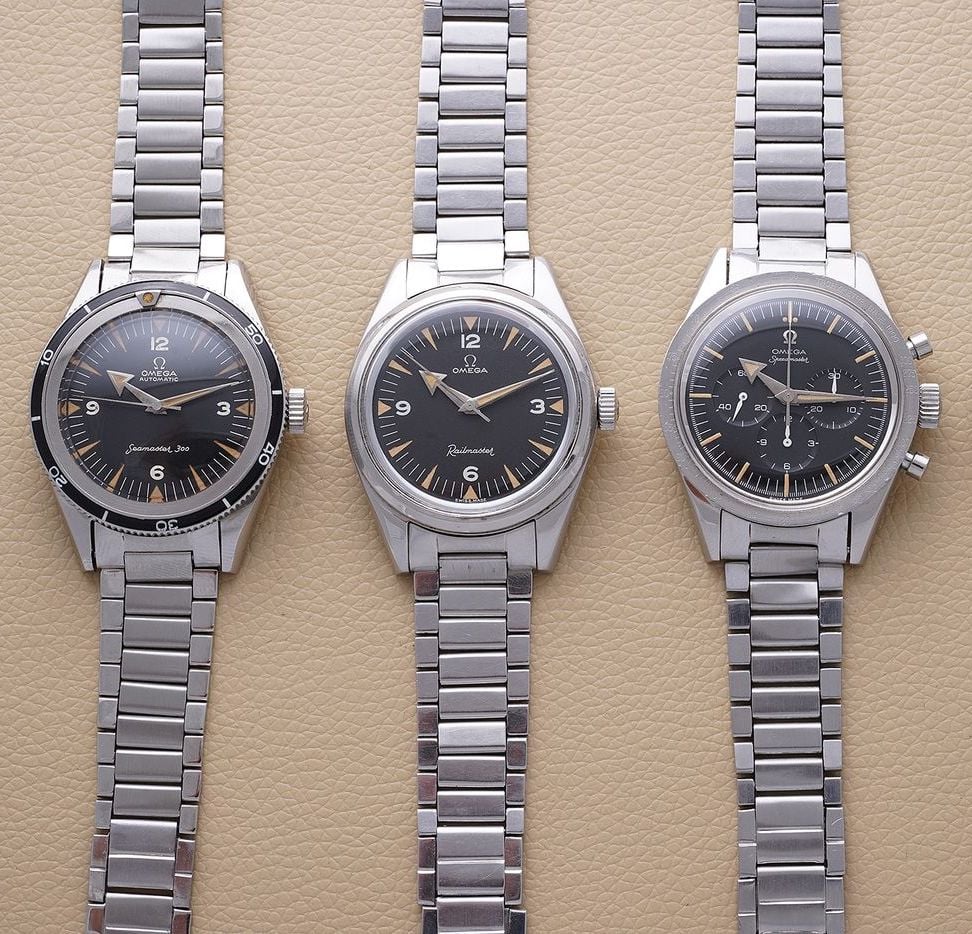
The particularity of the Speedmaster was the location of its tachymetre scale. Instead of appearing on the dial, the scale was relocated to the exterior and engraved on the steel bezel. Defined as a “high-precision wrist computer with tacho-productometer scale”, the Speedmaster was capable of measuring anything from the speed of a projectile to the production rate of a worker. With its black dial and sharp white contrasting markings and hands, the dial captured the sporty dashboards of Italian racing cars of that time.
The Race to Space
Meanwhile, 6,571 km away from Omega’s HQ in Bienne, the US Congress passed legislation to establish the National Aeronautics and Space Administration (NASA), a civilian agency responsible for coordinating America’s activities in space. The creation of NASA in 1958 was a direct response to the Soviet Union’s 1957 launch of the first satellite – Sputnik I – and marked the official start of the US-Soviet Space Race.
Below, Walter ‘Wally’ Schirra wearing his own Speedmaster CK 2998 on board of the recovery ship USS Kearsarge (3 October 1962) and Gordon Cooper who also privately bought a Speedmaster CK 2998 and took it in space, here strapping it in 1963 before flight.
The first Speedmaster (CK 2998) worn in space was on astronaut Walter Schirra’s wrist during the Sigma 7 mission of the Mercury programme in 1962. At this early stage in NASA’s development, watches were not part of the official astronaut kit and Walter Schirra’s Speedmaster was his personal wristwatch. As technology evolved, so did the requests of astronauts who insisted on mechanical backup timing devices. Flight Crew Operations Director, Deke Slayton, responded and issued a memo requesting robust, accurate chronographs for the Gemini and Apollo crews. In 1964 a tender was sent to 10 watch brands but only four responded. Of those four (Longines, Omega, Rolex and Hamilton), engineer James Ragan selected three: Hamilton was discarded because it sent a pocket watch chronograph instead of a wristwatch. The ensuing Qualification Tests, which are elucidated step-by-step in Brice’s article here, were designed to test the watches in the most extreme situations imaginable with radical oscillations in temperature, corrosive 100% oxygen environments, shocks of 40g and so on. Only one chronograph survived and in 1965 the Speedmaster (ST 105.003) was declared “flight-qualified by NASA for all manned space missions”.
As the certified watch for astronauts of Gemini and Apollo missions, the Speedmaster made its first ‘official’ flight into space onboard the Gemini III mission and on the wrists of Virgil (Gus) Grissom and John Young. It was also photographed on Edward White’s wrist during the first historic spacewalk – extra-vehicle activity (EVA) – during the Gemini IV mission of 1965. On 21 July 1969, Neil Armstrong entered the annals of history as the first American astronaut to set foot on the Moon. Yet, he wasn’t wearing his watch but Buzz Aldrin was, with his Speedmaster strapped over his bulky spacesuit with Velcro. Following this epic walk on the Moon, the Speedmaster became known as the Moonwatch.
One mission, in particular, the troubled 1970 Apollo 13 “Okay, Houston, we’ve had a problem here”, proved how vital the watch really was. Following an explosion of a reserve oxygen and hydrogen tank in the service module and the resulting system failure, Commander James Lovell relied on his Speedmaster to time the critical firing of the re-entry rockets allowing for the safe return of his crew to planet Earth.
The Speedmaster was present for yet another decisive moment in space history during the 1975 joint USSR-US Apollo-Soyuz docking. The symbolic handshake in space, the beginning of the end of the Space Race, revealed that both crews were wearing Speedmasters.
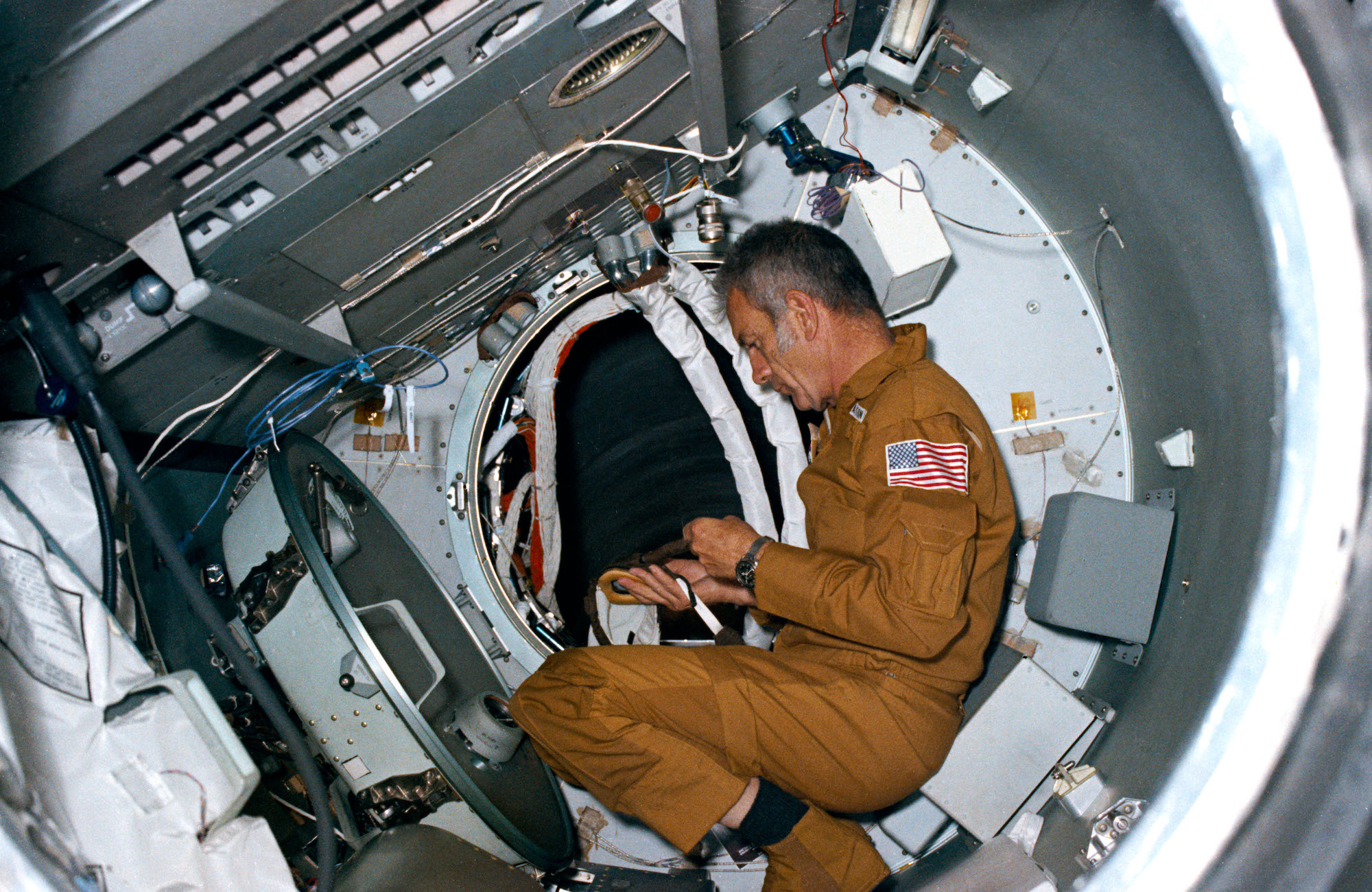
Although the popularity of Moon landings began to wane – the last man to set foot on the Moon was Eugene Cernan in 1972 – NASA implemented its Space Shuttle programme in 1978 and the Speedmaster was recertified as the official watch. With six Moon landings under its belt, accompanying every US manned space flight since 1965 and currently in Russia’s MIR International Space Station, the Speedmaster has been a witness and an ally in man’s greatest feats of exploration.
The Lemania Connection – Calibres 321 and 861
Before the Speedmaster even existed, its heart was already beating at Lemania’s manufacture in Villeret. Renowned for its outstanding watch movements, in particular chronographs, stopwatches and repeaters, Lemania once provided chronograph calibres for the big names in business. In 1941, Lemania produced the 27 CHRO C12, the ancestor of Omega’s calibre 321 that was, and still is, recognised as one the best and most beautiful hand-wound chronograph movements ever produced. The calibre was developed by Albert Piguet, the technical director of Lemania. The calibre, known as Lemania 2310, was also used by top watch brands, including Patek Philippe, Vacheron Constantin and Breguet from the 1940s up until very recently. Since 1932, Lemania had formed part of the SSIH (Société Suisse pour l’Industrie Horlogère) watch consortium, which also included brands like Omega and Tissot.
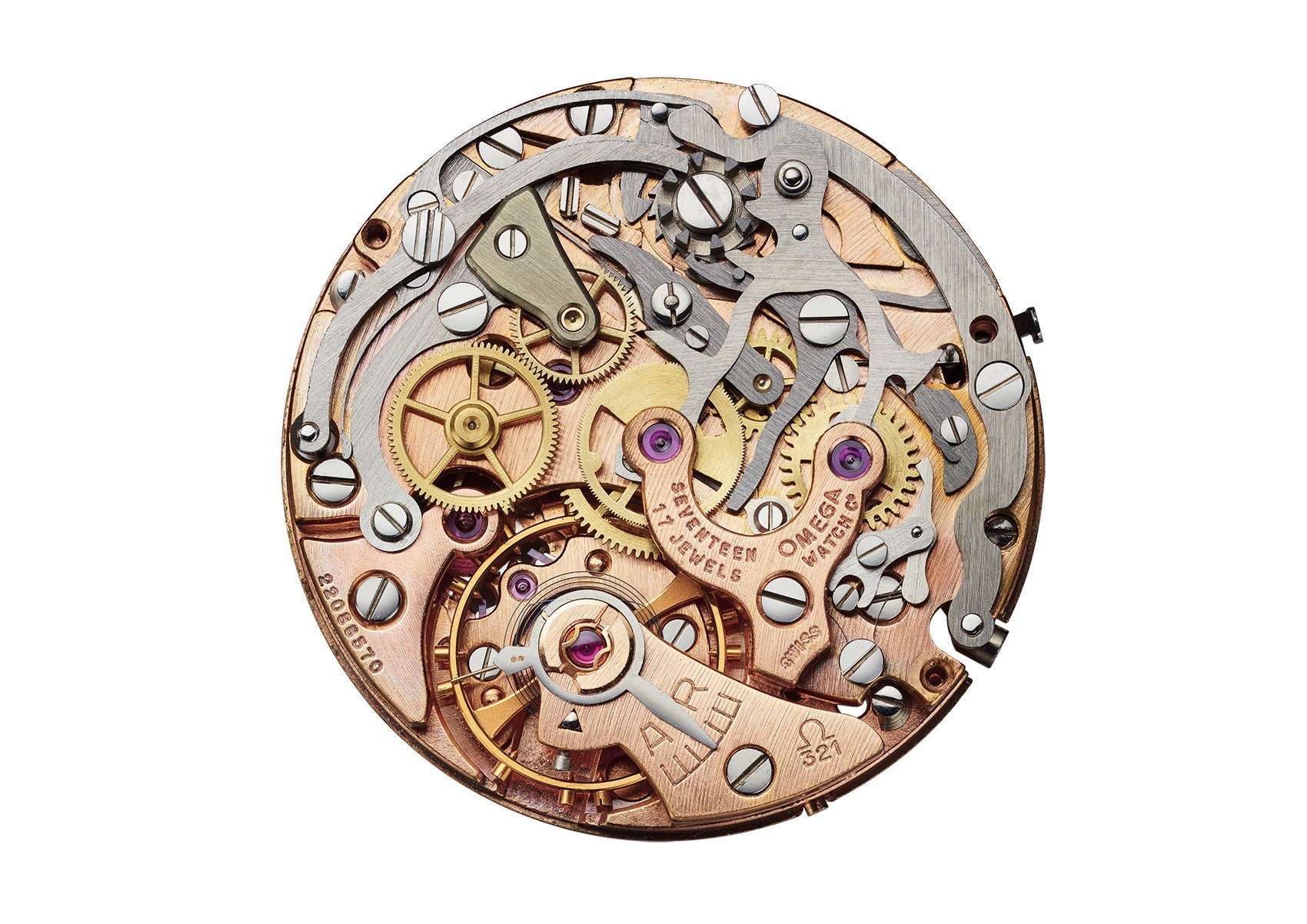
Lemania was in charge of the production of complicated movements for its sister brand Omega providing chronographs for the 1932 Olympic Games in Los Angeles and eventually for models like the Speedmaster. The robust components of calibre 321 were produced with a maximum of precision and could be interchanged without modification, a highly unusual feature of the time. The 321 beating inside the CK 2915 Speedmasters was the movement that made it into space and as such is the most coveted of all Speedmaster Moonwatch references.
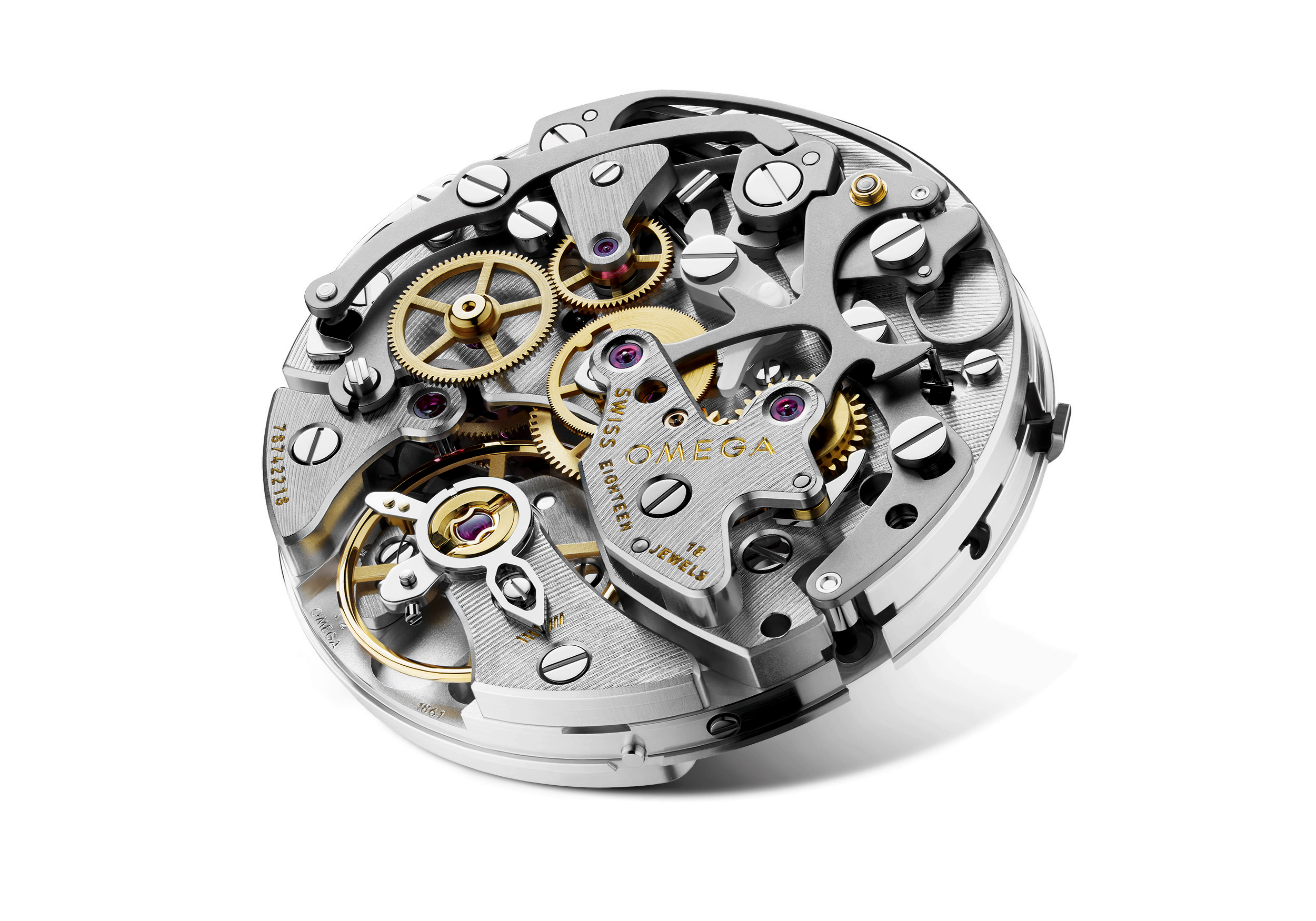
A derivation of the calibre 321, known as the calibre 861 (based on Lemania 1871), was introduced in 1968 to substitute the original calibre. With a flat balance and a higher frequency of 21,600vph, the 861 abandoned the column-wheel mechanism and replaced it with a more robust cam for the chronograph switching function. The steel brake lever of the central chronograph wheel will also later be substituted with a synthetic Delrin brake lever to absorb shocks. In short, the 861 featured improvements over the 321; it was simpler and cheaper to produce than the 321 and perfectly timed to meet the surging demand of the Speedmaster after it was spotted on the wrist of NASA astronauts.
The Bible of the Moonwatch
Just before we look at the iconic references of the watch, I’d like to express a few words of gratitude and admiration to Grégoire Rossier and Anthony Marquié, the authors of Moonwatch Only. A colossal 500+ page tome, Moonwatch Only is dedicated exclusively to the Speedmaster/Moonwatch phenomenon. How many other individual models can you think of with this kind of devotional following?
I relied extensively on this book for the article. Just to give you an idea of the scope of material covered in Moonwatch Only, almost every single adaptation of the species is recorded, from the features of every single calibre to the most infinitesimal details: Is the Omega logo applied in metal or painted on the dial? Is there a ‘T’ (for tritium) on either side of the Swiss Made inscription on the dial and is it a close ‘T’ or a spaced ‘T’? Is the dial stepped or not? Does the Omega logo on the crown have flat feet, angular feet or wide feet? What kind of hands are those – Broad Arrow, Alpha, baton? Is the bezel graduated to 1000 or 500? Does the caseback have a double bevel or a single bevel, is it a blank caseback or is it engraved with a Seahorse (hippocampus) or with Flight-Qualified by NASA? Is the caseback smooth or textured? Are those flat lugs or lyre lugs, short and wide pushers or wide and tall pushers? Not to mention the 20-odd references for the metal bracelets and the models with display casebacks, moon phases, limited and special series. You get the picture.
As the authors of Moonwatch Only point out, the history of this watch is not “an exact science”. The evolutions of the Speedmaster have not always been linear, references sometimes overlap one another in time and keeping up with the changing reference numbers is an art in itself. Be that as it may, if you are serious about collecting, it is worth investing in a copy of Moonwatch Only, a unique reference book where almost every manifestation of the watch is recorded in loving detail and substantiated with photographs. It is an excellent guide for amateur sleuths and seasoned collectors who want to make sure what they’re buying and avoid common pitfalls, a way of separating the wheat from the chaff.
GENESIS – CK 2915 ‘BROAD ARROW’
The most coveted of all Speedmasters, the CK 2915 was the first reference, the progenitor of this famous family. Launched in 1957 as part of the Master Trilogy (see above), the Speedmaster was the first chronograph to feature the tachymetre scale on an external bezel. With its steel bezel with engraved numbers and a base 1000 tachymetre scale, its black dial with three recessed sub-dials, its distinguishing Broad Arrow hour hand, its radium-filled indices and hands, the first Speedmaster was pitched as the watch for men “who reckon time in seconds”.
Omega fitted the Speedmaster with the Lemania-produced calibre 321 (based on the Lemania 2310, see above), a manual-winding column-wheel chronograph with a lateral clutch, a shock-protection mechanism and an anti-magnetic cover.
In production for three years from 1957-1959 with three references, the last reference was 2915-3. Produced in 1959, it is regarded as a transitional model substituting the Broad Arrow hands for Alpha hands and highlighting the bezel in black for enhanced legibility.
The CK 2915 Speedmaster is considered the ultimate grail watch. What is surprising is how clearly the traits of this watch have marked the evolution of every Speedmaster model to come.
Identikit CK 2915
- Nickname: Broad Arrow
- Case: 39mm, stainless steel, symmetrical, straight lugs, no crown guards
- Movement: calibre 321
- Dial: black with luminous radium, stepped, recessed sub-dials
- Glass: Hesalite
- Hands: Broad Arrow and then Alpha (2915-3)
- Bezel: steel with engraved numerals originally and later black bezel (2915-3), Tachymètre Base 1000
- Ref.and production dates: CK 2915-1 (1957-1958); CK 2915-2 (1958-1959); and CK 2915-3 (1959)
THE EVOLUTION – CK 2998 First ‘unofficial’ Speedmaster in Space
The CK 2998 marked the next stage in the Speedmaster’s evolution and substituted the CK 2915 in 1959. Its claim to fame is the fact that it was the first ‘unofficial’ Speedmaster in space; it was Wally Schirra’s personal watch which he used during the Sigma 7 Mission of 1962 (see paragraph on The Race to Space). Following the changes made to the CK 2915-3, the CK 2998-1 featured a black aluminium bezel (which makes it slightly larger than the CK 2915, at 39.7mm) and Alpha hands.
Still powered by the first-generation calibre 321, there were 6 sub-references of this model with subtle changes like the optional lollipop hand with drop counterweight for the chronograph seconds or the optional pulsometer scale to substitute the tachymetre scale, as well as the change in scale from base 1000 to base 500 (2998-3). Another improvement was the addition of O-ring gaskets around the pushers to improve water-resistance.
Identikit CK 2998
- Case: 40mm, stainless steel, symmetrical, straight lugs, no crown guards
- Movement: calibre 321
- Dial: black with luminous radium, stepped, recessed sub-dials
- Glass: Hesalite
- Hands: Alpha, optional lollipop chronograph seconds hand
- Bezel: black aluminium insert, Tachymètre Base 1000, then 500 (2998-3), optional pulsometer (2998-2) or decimal scale (2998-61)
- Ref. and production dates: CK 2998-1 (1959-1960); CK 2998-2 (1960); CK 2998-3 (1960-1961); CK 2998-4 (1961-1962); CK 2998-5 (1962); and CK 2998-6, 2998-61, 2998-62 (1962-1963)
It’s worth mentioning that in 1962 the original coding system was replaced by the more elaborate Mapics system. The pre-1962 code applied to two models – CK 2915 and CK 2998 – the CK an abbreviation for Staybrite stainless steel. The first Speedmaster with a Mapics reference is the ST 105.002, a similar watch to the CK 2998 which was only produced for two years between 1962-1964. One of the distinguishing features of the 1964 ref. ST 105.002 was the introduction of hour and minute baton hands in 1964.
The NASA qualified ‘Ed White’ Model – ST 105.003
The ST 105.003 is the reference that passed the 11 gruelling NASA Qualification Test Procedures (see paragraph on the Race to Space) in 1965 and the first watch to take a walk in space on Ed White’s wrist during the first EVA spacewalk during the Gemini IV mission of 1965. It is also the last Speedmaster to feature straight lugs.
Just to confuse things, the name of the ST 105.003 was changed to ST 145.003 in 1967 due to another change in the coding system. Another novelty was the incorporation of the letter ‘T’ on either side of the Swiss Made inscription on the dial to indicate the presence of radioactive tritium used for luminescence.
Identikit ST 105.003
- Nickname: Ed White
- Case: 39.7mm, stainless steel, symmetrical, straight lugs, no crown guards
- Movement: calibre 321
- Dial: black, luminous tritium, recessed counters
- Glass: Hesalite
- Hands: baton with tritium, central chronograph hand with diamond-shaped tip treated with tritium and drop counterweight
- Bezel: black anodised aluminium, tachymetre base 500, optional pulsometer bezel (105.003-65)
- Ref. and production dates: ST 105.003-63 and ST105.003-64 (1964-1966); ST 105.003-65 & ST 145.003 (1966-1969)
The Moonwatch – ST 105.012
Research at the Omega Museum in Bienne proves, beyond a shadow of a doubt, that ST 105.012 was the reference that landed on the Moon in 1969. Both Neil Armstrong and Buzz Aldrin were wearing ST 105.012 models. Although NASA trials were conducted with the ST 105.003, the ST 105.012 was authorised for use in space without any further testing.
In addition to the historic Moon landing, the ST 105.012 revealed important changes in the construction of the case to make it more robust. The exposed pushers and crown were given protective buttresses creating an asymmetrical case design and the lugs were bevelled and twisted to become the hallmark ‘lyre lugs’ of the Speedmaster. The ST 105.012 is also famous because it was one of the last Speedmasters equipped with the beautiful column-wheel chronograph calibre 321 and the first to feature the Professional inscription from the beginning of its production in 1964.
The last model to host the beloved calibre 321 was the ST 145.012. Slightly different from the ST 105.012, this model had pushers with taller caps that were screwed into the caseband and was worn by several astronauts on different Apollo missions.
Identikit ST 105.012
- Case: 42mm, stainless steel, new asymmetrical caseband design to protect pushers and crown, twisted ‘lyre’ lugs
- Movement: calibre 321
- Dial: black, luminous tritium, recessed counters
- Glass: Hesalite
- Hands: baton with tritium, central chronograph hand with diamond-shaped tip and tritium
- Bezel: black anodised aluminium
- Ref. and production dates: ST 105.012-63 (1964); ST 105.012-64 (1965-1966); ST 105.012-65 (1966-1967); ST 105.012-66 (1967-1968)
The first calibre 861 model – ST 145.022
In 1968, calibre 321 was eventually phased out and replaced with calibre 861. Also made by Lemania and developed by Albert Piguet, the calibre 861 featured a cam-controlled chronograph and marks the second major evolution in the life of the Speedmaster. Some stylistic changes were also incorporated on the ST 145.022 models with the chronograph hand featuring a flat counterweight as opposed to the former drop counterweight and the accented È on tachymètre was eliminated on models produced from 1970 on. Photos below by Bulang & Sons.
The ST 145.022 has had numerous designations. In the 1970s the Mapics system introduced a seven-figure reference to become ST 145.0022 and in 1988 another coding system, known as Product Identity Code or PIC, was introduced.
Highlights of ST 145.022
- ST 145.022-68 was the first model to host the new 861 calibre.
- ST 145.022-69 aka Straight Writing by collectors, which appeared in 1971, is the first model with a caseback engraved with: THE FIRST WATCH WORN ON THE MOON (centre of caseback) and FLIGHT-QUALIFIED BY NASA FOR ALL MANNED SPACE MISSIONS (around the periphery). It was nicknamed Straight Writing because the text in the centre of the dial was linear. An even rarer model with the same reference number was inscribed with THE FIRST WATCH WORN ON THE MOON (in centre) and OMEGA SPEEDMASTER – APOLLO XI 1969 (on circumference) delivered in 1972 to Japan
- ST 145.022-71 similar to above model but with a Speedmaster medallion in the centre of the caseback
- ST 145.022-74 is the first model to feature a dial without the step separating the minutes scale
New classifying systems introduced in the early 1980s and again in 1988 meant another upheaval in reference numbers
- A seven-digit reference number from early 1980s-1988 meant that the ST 145.022 appeared as the ST 145.0022
- In 1988, another code was adopted. Product Identity Code or PIC made its debut on board the PIC 3590.50
- The last model with tritium hands and markers was the PIC 3570.50 Tritium replaced in 1997 by non-radioactive luminova, a pigment-based luminescent material that charges with light. The PIC 3570.50 Luminova heralded the introduction of this material, which is still in use today
- The other significant change was the renaming of calibre 861 to become calibre 1861 between 1996-1997. The new numbering indicated the introduction of a corrosion-resistant rhodium-plated movement to replace the former yellow plating
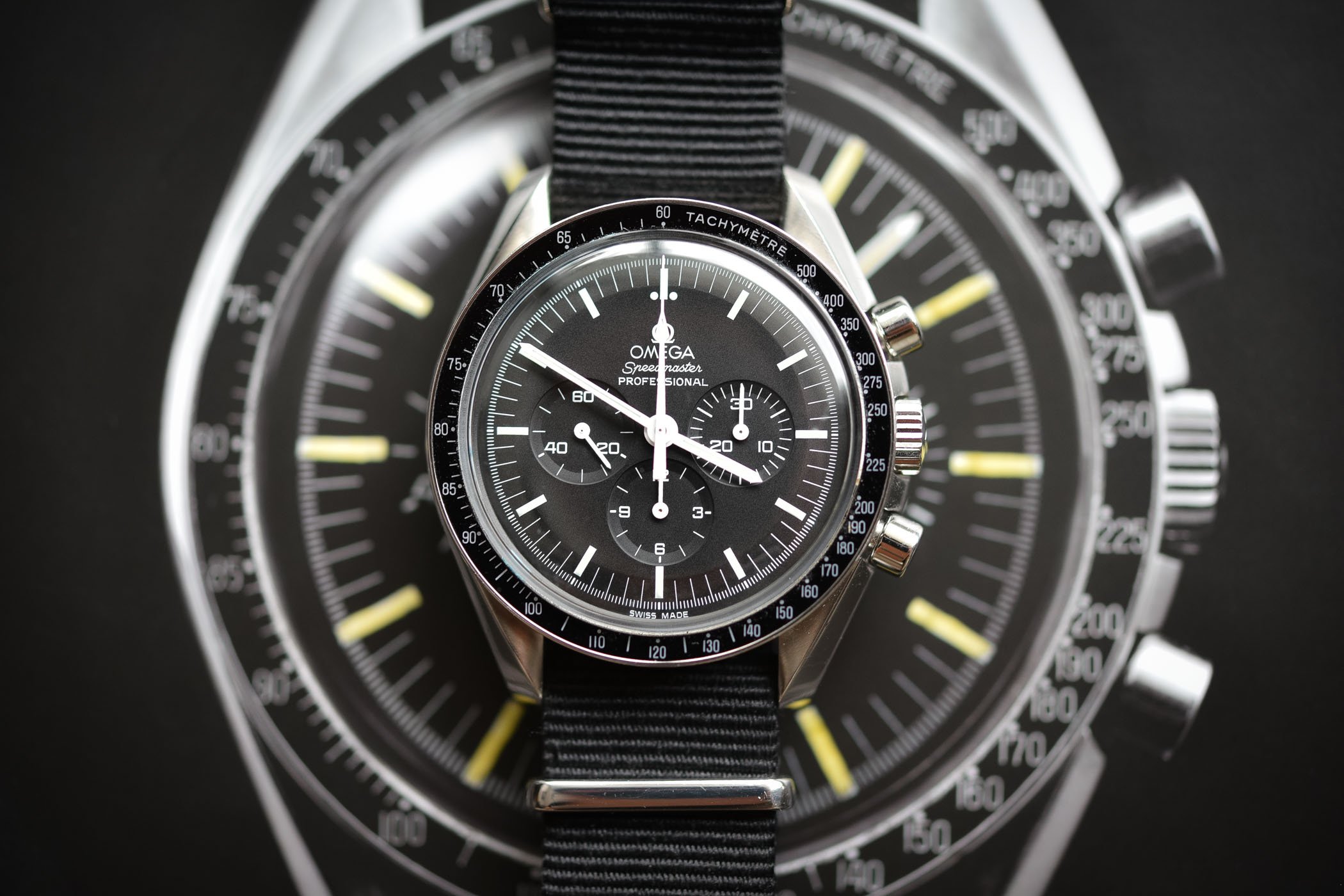
As you can imagine, there have been and will continue to be countless variations on the Moonwatch theme: from models with open casebacks, anniversary models, special numbered editions, moon phases, limited series, tributes to astronauts, mission models, MIR space station models, gold and diamond skeletonised models, faithful reproductions of the CK 2915, even a Snoopy model to celebrate NASA’s Snoopy Award to Omega in 1970…Ample proof of the unwaning popularity of the Moonwatch.
There are plenty of articles on MONOCHROME covering the early history of the Speedmaster, the 1970s phase of Speedmasters and the Alaska Project, and the rare and limited editions. And of course, Omega has posted its own beautifully illustrated 60th-anniversary retrospective of this legendary watch on its website.

